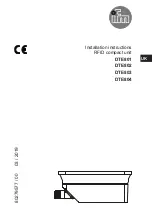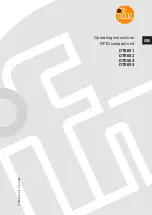
Rev. 11/10/2020
OLA-4 MANUAL
Copyright 2020 Vestil Manufacturing Corp. Page 7 of 8
INSPECTIONS AND MAINTENANCE
Regular inspections and maintenance are essential. Always inspect and maintain this product
in accordance with the instructions in this manual.
Inspections and repairs should be performed by qualified persons. Compare the results of each
inspection to the
. Do not use the lifter unless all parts are in
satisfactory condition. Replace parts that are not in satisfactory condition before returning the lifter to
service. Only use manufacturer-approved replacement parts to restore the unit to satisfactory condition.
DON’T GUESS!
If you have any questions about the condition of your lifter, contact the
department.
The phone number is provided on the cover page of this manual.
Never make
temporary repairs of damaged or missing parts
.
Every lift
– The operator must inspect the lifter before every lift. Closely inspect the bale mechanisms.
Check the bale loop and bale pin for cracks, elongation, warps, and other forms of damage. Confirm that the
bale mechanism is securely pinned in place. Remove debris from the surfaces of the forks.
Monthly Inspections
– At least once per month a qualified person must perform the following
inspections. Written reports should be prepared for every monthly inspection including inspections following
1.
Frame elements:
Examine all frame elements (inner frame tube; outer frame tube; fork carriage) for
deformation, cracks, severe wear, corrosion/rusting, and metal fatigue. If rusting is purely superficial,
remove it with a steel bristle brush or steel wool. Clean the affected area and apply touchup paint. If
rusting, rot, or thinning has weakened the material, contact
TECHNICAL SERVICE
for advice.
2.
Pins and fasteners:
Examine all pins (bale pin; height adjustment pin; width adjustment pins). Pins
should be straight. Examine retaining clips used to secure pins in place. Confirm that both detent pins
(OLA-4-42) retract automatically.
3.
Bale assemblies:
Measure the length and width of the bale openings. Make sure the measurements
match the measurements in the
4.
Forks:
Thoroughly examine both forks. Look for cracks and severe wear. Confirm that each fork attaches
normally to the carriage.
5.
Snap hooks and chains:
Examine the chains and snap hooks. Hooks should not be bent, cracked,
twisted, or otherwise deformed. Latches should automatically close. Chain links should not be damaged,
e.g. bent, cracked, or stretched.
6.
Labels:
Check all labels. Labels are shown in the
(below). Replace labels that are
missing, damaged, or not easily readable.
LABELING DIAGRAM
Label content and location are subject to change so your product might not be labeled exactly as shown.
Compare the diagram below with the
. If you have any questions about labeling, contact
TECHNICAL SERVICE
. Replace all labels that are damaged, missing, or not easily readable (e.g. faded).
To order replacement labels, contact the technical service and parts department online at
http://www.vestilmfg.com/parts_info.htm
. Alternatively, request replacement parts and/or service by calling
(260) 665-7586 and asking the operator to connect you to
A: Label 991
B: Label 675
C: Label 531
D: Label 320
A
D
C
B


























